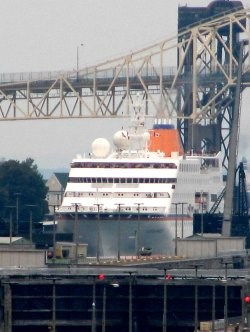Forget all that talk about a deep-water port, Sault Ste. Marie.
You're not getting one.
Not now.
Not ever.
But you just might get a garden-variety port, if the City of Sault Ste. Marie gets its way.
Last night, Ward 6 Warhorse Frank Manzo succinctly corrected Bill Therriault, coordinator of the City's transportation infrastructure steering committee, as Therriault was petitioning City Council for support for a deep-water port in Sault Ste. Marie.
Manzo pointed out that, in the world of marine infrastructure, when a person says deep-water port it's taken to mean way deep.
Like more than 12 metres or about 40 feet deep.
The current depth of the area that would become Sault Ste. Marie's port is mostly about eight metres (26 feet), Manzo said.
"There's just no way you're ever going to get that down to 40 feet," the Ward 6 councillor said. "Not on the rocky side below the locks."
Therriault was quick to agree with Manzo, with the rest of City Council agreeing to drop the words 'deep-water' and just call it a port.
Either way, the transportation infrastructure committee now has the support of the City to go find out whether a port is a good idea, or just a little to deeply ambitious for the Sault in the foreseeable future.
Seen above is the 423-passenger cruise ship MS Columbus as she locked downbound on October 2, 2007.
This was to be the last trip of the Columbus through the lakes that year as water levels were unusually low - too low to accommodate the ship's 6.5-metre draft.
But the ship has returned to the Bondar Marina since water levels rose again.
Therriault said that dreams of expansion at Essar Steel Algoma and Tenaris Algoma Tubes would sink without a port in the Sault.
Most ocean-goers must offload and send their cargo across the dock, often in Montreal, to lakers for transport through the St. Lawrence River between Montreal and Lake Ontario and through the Welland Canal.
Maximum draft for these areas is up to eight metres (26 feet, six inches) for much of the shipping season says the seaway website.
A ship must be no more than 225.6 metres (740 feet) in length, 23.8 meters (78 feet) wide, and have a a height above the waterline of not more than 35.5 metres (116 ft) to pass through the Welland Canal, which was built to allow marine traffic to circumnavigate Niagara Falls.
A Seaway Max vessel; or maximum-sized vessel able to navigate the St. Lawrence River, can carry no more than about 28 thousand tons of cargo.
However, vessels navigating the Great Lakes can be larger and carry more cargo.
Their size is currently limited by the size of the Poe Lock in Sault Ste. Marie, Michigan which can handle ships up to 304.8 metres (1,000 feet) long and 32 metres (105 feet) wide.
The Poe Lock is 9.8 metres (32 feet) deep, but the channels through the St. Mary's River; on which the lock is built, are maintained at a low-water depth of 7.8 metres (25 feet, five inches).
For every inch the water rises, ships can carry an additional 200 tons of cargo.
Generally speaking, the deeper the water, the cheaper the shipping costs.
And there are plenty of goods to be shipped around the Great Lakes.
Both Tenaris and Essar receive raw materials by laker delivered from ports on the lakes.
They also ship their products to ports on the lakes.
Therriault said there's plenty of marine traffic through the Sault as goods and materials that have been either mined near ports, produced near ports or brought by land transport to the ports are moved around the lakes.
The trick is to see whether it's enough traffic to warrant a port in the Sault.
A planned superlock for the Michigan Soo is still awaiting funding and if, or when, that project goes ahead, it would accommodate much larger ships that are able to carry much more cargo.
But only if the channels through the river were dredged deeper, as would happen if a port were constructed here, Therriault said.
Ward 6 Councillor Joe Krmpotch asked whether such activity would present any dangers to the environment or to people in the area of development.
Therriault responded that a large portion of the cost to create a port here would be to meet the stringent standards for dredging set out by the Ontario Ministry of the Environment and by Fisheries and Oceans Canada.
City Council has mandated the transportation infrastructure steering committee to find out whether it would be possible to create a port in the Sault that would allow larger, more heavily loaded vessels.
Council wants to know if a port would make the Sault more attractive to business and spur significant economic growth as well as diversification, as Therriault suggests it would.
Last night it put $200,000 of its money on the task by earmarking the funds for the committee's use.
Therriault said the committee would likely be returning to City Council with a preliminary report on its activities in about three months.
The money will come from funds allocated by the City to save the Huron Central railroad.
City Council originally allocated $250,000 for that purpose, but only $50,000 was spent.
